-
Countries
-
Data and Analysis
-
Special Focus
-
Crisis Responses
Return migration
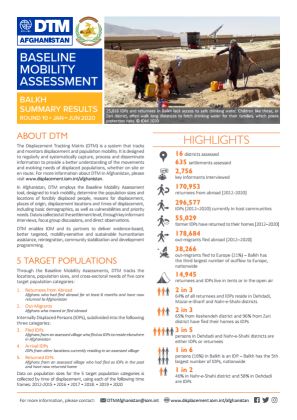
Contact
DTMAfghanistan@iom.int
Language
English
Location
Afghanistan
Period Covered
Jan 01 2020
Jun 30 2020
Activity
- Mobility Tracking
- Baseline Assessment
In Afghanistan, DTM employs the Baseline Mobility Assessment tool, designed to track mobility, determine the population sizes, locations and geographic distribution of forcibly displaced, return and migrant populations, reasons for displacement, places of origin, and times of displacement, as well as basic demographics, vulnerabilities and priority needs. Data is collected at the settlement level, through community focus group discussions with key informants and direct observations.
This provincial report summarises the DTM findings in Balkh. The data has been collected throughout 16 districts and 635 settlements in Balkh.
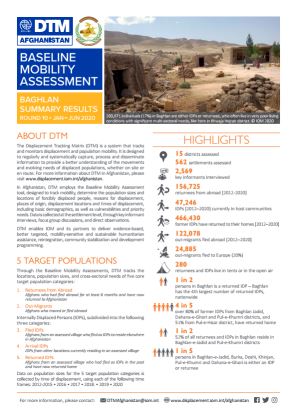
Contact
DTMAfghanistan@iom.int
Language
English
Location
Afghanistan
Period Covered
Jan 01 2020
Jun 30 2020
Activity
- Mobility Tracking
- Baseline Assessment
In Afghanistan, DTM employs the Baseline Mobility Assessment tool, designed to track mobility, determine the population sizes, locations and geographic distribution of forcibly displaced, return and migrant populations, reasons for displacement, places of origin, and times of displacement, as well as basic demographics, vulnerabilities and priority needs. Data is collected at the settlement level, through community focus group discussions with key informants and direct observations.
This provincial report summarises the DTM findings in Baghlan. The data has been collected throughout 15 districts and 562 settlements in Baghlan.
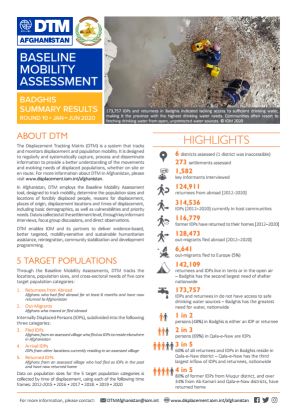
Contact
DTMAfghanistan@iom.int
Language
English
Location
Afghanistan
Period Covered
Jan 01 2020
Jun 30 2020
Activity
- Mobility Tracking
- Baseline Assessment
In Afghanistan, DTM employs the Baseline Mobility Assessment tool, designed to track mobility, determine the population sizes, locations and geographic distribution of forcibly displaced, return and migrant populations, reasons for displacement, places of origin, and times of displacement, as well as basic demographics, vulnerabilities and priority needs. Data is collected at the settlement level, through community focus group discussions with key informants and direct observations.
This provincial report summarises the DTM findings in Badghis. The data has been collected throughout 6 districts and 273 settlements in Badghis.
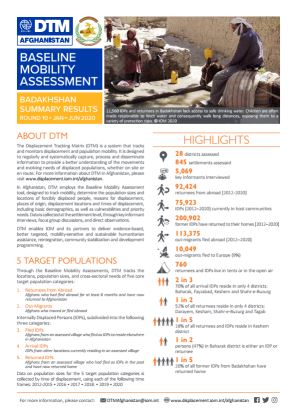
Contact
DTMAfghanistan@iom.int
Language
English
Location
Afghanistan
Period Covered
Jan 01 2020
Jun 30 2020
Activity
- Mobility Tracking
- Baseline Assessment
In Afghanistan, DTM employs the Baseline Mobility Assessment tool, designed to track mobility, determine the population sizes, locations and geographic distribution of forcibly displaced, return and migrant populations, reasons for displacement, places of origin, and times of displacement, as well as basic demographics, vulnerabilities and priority needs. Data is collected at the settlement level, through community focus group discussions with key informants and direct observations.
This provincial report summarises the DTM findings in Badakhshan. The data has been collected throughout 28 districts and 845 settlements in Badakhshan.
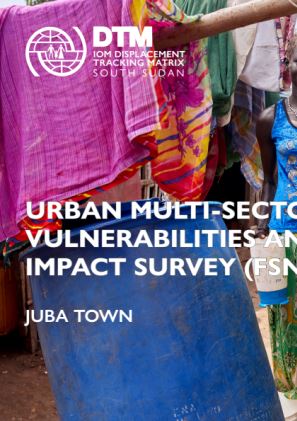
Contact
DTM South Sudan, SouthSudanDTM@iom.int
Language
English
Location
South Sudan
Period Covered
Aug 01 2020
Sep 30 2020
Activity
- Survey
During the second half of 2020, the International Organization for Migration’s Displacement Tracking Matrix (IOM DTM) and the World Food Programme’s Vulnerability Analysis and Mapping (WFP VAM) units undertook a joint household-level assessment of selected urban areas and camps for internally displaced persons (IDPs) in South Sudan. The assessment aims to:
- Quantify the prevalence of vulnerabilities and humanitarian needs across sectors, with a focus on food security and economic vulnerability as well as selected indicators on shelter and non-food items, water, hygiene and sanitation (WASH), protection (including child protection and gender-based violence) and mental health and psycho-social support (MHPSS).
- Generate a better understanding of urban displacement and migration, including return and relocation after displacement in South Sudan or abroad.
- Evaluate the impact of the COVID-19 pandemic and related restrictions on human mobility, livelihoods and access to humanitarian services, and gather key information on household awareness and adoption of preventive measures.
The assessment contributed to the extended Food Security and Nutrition Monitoring System (FSNMS+) initiative to pilot a household-level multi-sector needs assessment for South Sudan. In addition to WFP and IOM, the FSNMS+ initiative saw the participation of the United Nations Children’s Fund (UNICEF), the Food and Agriculture Organization (FAO), the United Nations Office for the Coordination of Humanitarian Affairs (OCHA), FEWSNET, REACH and several humanitarian clusters. By expanding FSNMS coverage to key urban areas and IDP camps, the assessment addresses a longstanding information gap for the humanitarian response. This report presents sectoral findings for Juba’s urban area.
Separate profiles will be released for Juba IDP camps I and III, Wau’s urban area and Naivasha IDP camp, the urban area of Bentiu / Rubkona and Bentiu United Nations Mission In South Sudan (UNMISS) Protections of Civilians (PoC) site, and Malakal’s urban area and PoC site.
Note: The report was re-uploaded on 11 May 2021 to correct an error in the education section.
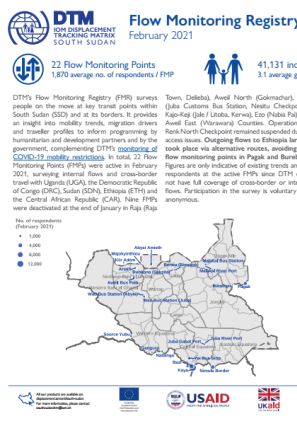
Contact
DTM South Sudan, SouthSudanDTM@iom.int
Language
English
Location
South Sudan
Period Covered
Feb 01 2021
Feb 28 2021
Activity
- Flow Monitoring
DTM’s Flow Monitoring Registry (FMR) surveys people on the move at key transit points within South Sudan (SSD) and at its borders. It provides an insight into mobility trends, migration drivers and traveller profiles to inform programming by humanitarian and development partners and by the government, complementing DTM’s monitoring of COVID-19 mobility restrictions. In total, 22 Flow Monitoring Points (FMPs) were active in February 2021, surveying internal flows and cross-border travel with Uganda (UGA), the Democratic Republic of Congo (DRC), Sudan (SDN), Ethiopia (ETH) and the Central African Republic (CAR). Nine FMPs were deactivated at the end of January in Raja (Raja Town, Delieba), Aweil North (Gokmachar), Juba (Juba Customs Bus Station, Nesitu Checkpoint), Kajo-Keji (Jale / Litoba, Kerwa), Ezo (Nabia Pai) and Aweil East (Warawara) Counties. Operations at Renk North Checkpoint remained suspended due to access issues. Outgoing flows to Ethiopia largely took place via alternative routes, avoiding the flow monitoring points in Pagak and Burebyei. Figures are only indicative of existing trends among respondents at the active FMPs since DTM does not have full coverage of cross-border or internal flows. Participation in the survey is voluntary and anonymous.
Please click here to access the dataset.
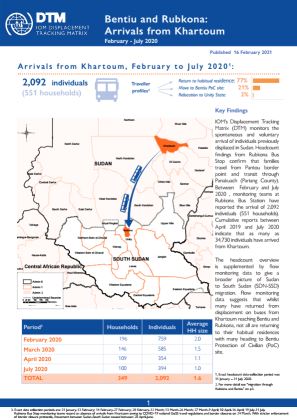
Contact
DTM South Sudan, SouthSudanDTM@iom.int
Language
English
Location
South Sudan
Period Covered
Feb 01 2020
Jul 31 2020
Activity
- Mobility Tracking
- Event Tracking
IOM’s Displacement Tracking Matrix (DTM) monitors the spontaneous and voluntary arrival of individuals previously displaced in Sudan. Headcount findings from Rubkona Bus Stop confirm that families travel from Pantou border point and transit through Panakuach (Pariang County). Between February and July 2020 , monitoring teams at Rubkona Bus Station have reported the arrival of 2,092 individuals (551 households). Cumulative reports between April 2019 and July 2020 indicate that as many as 34,730 individuals have arrived from Khartoum.
The headcount overview is supplemented by flow monitoring data to give a broader picture of Sudan to South Sudan (SDN-SSD) migration. Flow monitoring data suggests that whilst many have returned from displacement on buses from Khartoum reaching Bentiu and Rubkona, not all are returning to their habitual residences with many heading to Bentiu Protection of Civilian (PoC) site.
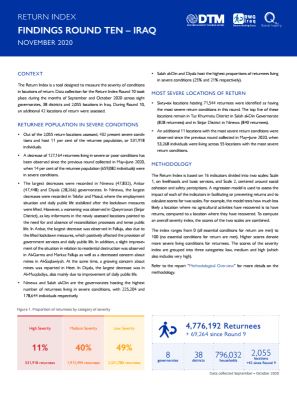
Contact
DTM Iraq, IraqDTM@iom.int
Language
English
Location
Iraq
Period Covered
Sep 01 2020
Oct 31 2020
Activity
- Survey
- Return Intention
- Mobility Tracking
- Baseline Assessment
The Return Index is a tool designed to measure the severity of conditions in locations of return. Data collection for the Return Index Round 10 took place during the months of September and October 2020 across eight governorates, 38 districts and 2,055 locations in Iraq. During Round 10, an additional 42 locations of return were assessed.

Contact
DTM Iraq, IraqDTM@iom.int
Language
English
Location
Iraq
Period Covered
Nov 01 2020
Dec 31 2020
Activity
- Survey
- Return Intention
- Mobility Tracking
- Baseline Assessment
The Return Index is a tool designed to measure the severity of conditions in locations of return. Data collection for the Return Index Round 11 took place during the months of November and December 2020 across eight governorates, 38 districts and 2,076 locations in Iraq. As this round is the last of 2020, some of the changes recorded throughout the year are presented. Since the Return Index Round 7 (collected in November – December 2019), an additional 322 locations of return were assessed (21 locations since Round 10 collected in September – October 2020).

Contact
DTM South Sudan, SouthSudanDTM@iom.int
Language
English
Location
South Sudan
Period Covered
Jul 01 2020
Dec 31 2020
Activity
- Mobility Tracking
This joint dashboard on health care access for internally displaced persons (IDPs) and returnees in South Sudan is the result of an ongoing collaboration between IOM’s Displacement Tracking Matrix (DTM) and WHO's Health Service Functionality (HSF) teams. The interactive report provides a countrywide summary of gaps in access to functional health facilities by IDPs and returnees. To view the interactive report, please unzip the attachment and open the html document with any web browser (e.g. Firefox, Chrome, Internet Explorer).
Summary
32.8 percent of IDPs (529,470 individuals) and 33.6 percent of returnees (562,019 individuals) live in settlements located more than 5km from a functional health facility.
Upper Nile (206,938), Warrap (169,189), and Jonglei (163,079) States have the highest numbers of IDPs and returnees living farther than 5km from a functional health facility.
Warrap (50.5%), Upper Nile (38.9%), and Jonglei (35.9%) States have the highest percentage of total IDPs and returnees living farther than 5km from a functional health facility.
Morobo (84.8%), Kapoeta East (82.5%), Tonj East (79.5%), and Guit (77.7%) Counties have the highest percentage of total IDPs and returnees living farther than 5km from a functional health facility.
Important notes & limitations
Health service availability data was compiled by WHO and reflects health service availability reported as of 31 December 2020.
Data on Internally displaced persons (IDP) and returnee settlements was collected by IOM DTM between July and September 2020 as part of round 9 of Mobility Tracking.
There are 126 health facilities that are functional, but for which GPS coordinates are unavailable and are not included in this analysis.
Health service availability data summarizes available information and was not collected using formal surveys and sampling methods, meaning there are data gaps and difficult to access and non-functional facilities facilities not supported by partners are likely underrepresented.
Changes in reported health care access from the July 2020 report may be due to changes in numbers of those in need, improved geolocation of IDP/returnee settlements, improved geolocation of health facilities, improvements in service availability, and/or the identification of GPS coordinates for health facilities which did not have them previously, as the facility list is continually cleaned and revised with newly available information.
Questions or comments
- For any questions on the analysis or health service availability data, please contact Malick Gai gaim@who.int, HSF Project Manager, or Ryan Burbach rmburbach@gmail.com, HSF Technical Adviser
- For any questions on IOM DTM data on IDP and returnee settlements, please contact southsudandtm@iom.int
Pagination
- Previous page
- Page 24
- Next page
